Damselfish
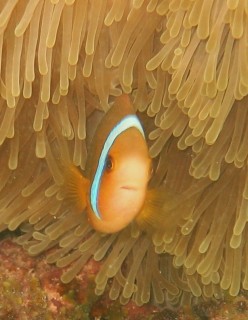 Damselfish (family Pomacentridae) create bright ovals of energetic color on the
reefs. They are very common and so plentiful that the reef seems to be alive
with darting, turning, hiding, often curious small colorful ovals. There are
over 240 species of damselfish in the Indo-Pacific. They all have a continuous
dorsal fin and a forked or lunate tail. They are all egg layers. Either the male
or female makes a nest on the bottom where they engage in courtship displays of
rapid swimming and fin extension. They feed on algae or plankton. Included in
this family are damselfish, sergeants, chromis, Dascyllus, and demoiselles.
Photos copyrighted Hackingfamily.com, with credits to Christopher Hacking unless
otherwise noted.
Damselfish (family Pomacentridae) create bright ovals of energetic color on the
reefs. They are very common and so plentiful that the reef seems to be alive
with darting, turning, hiding, often curious small colorful ovals. There are
over 240 species of damselfish in the Indo-Pacific. They all have a continuous
dorsal fin and a forked or lunate tail. They are all egg layers. Either the male
or female makes a nest on the bottom where they engage in courtship displays of
rapid swimming and fin extension. They feed on algae or plankton. Included in
this family are damselfish, sergeants, chromis, Dascyllus, and demoiselles.
Photos copyrighted Hackingfamily.com, with credits to Christopher Hacking unless
otherwise noted.
Brightly colored Anemonefish (yes, related to
Nemo, the clownfish!) live co-existent lives with about 10 species of host
anemone. While it seems clear that the anemone, with its stinging
tentacles, offers protection to the fish, it is not so clear what the fish offers
the anemone. Perhaps nothing, as anemones without fish are commonly seen,
but the anemonefish are never seen far away from the protection of an
anemone. Anemonefishes live in small groups with a dominant female and a
smaller, sexually active male, and several even smaller males and
juveniles. When the dominant female dies, the largest male changes sex
to become the head of the harem.We believe this species in the
photo on the right is Amphiprion bicentrus, in Tahitian Atoti. It
baffled us for a long time because it's not in any of our ID books.
We finally saw a picture in a museum in Tahiti which showed the Atoti with
its all-orange body with two white/blue bars, the rear one thinner. (Moorea)
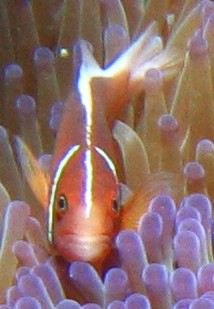 |
Pink Anemonefish Amphiprion perideraion looks
hauntingly pitchfork-esque from the front, and appears more orange than
pink amongst the purple-tipped Magnificent Anemone. The Pink Anemonefish
lives in 4 different anemones but prefers the Magnificent. It's found
from Indonesia across to E. Micronesia, and from Japan south to the
Great Barrier Reef. (New Caledonia) |
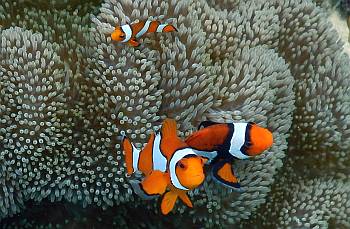
Clown Anemonefish have varying amounts of black |
At left: Hello Nemo! The Clown Anemonefish Amphiprion percula (left) is found
in the western Pacific Ocean from Vanuatu and the Solomon Islands to PNG and Eastern Indonesia. They live with any of 3
different anemone species to 47' (15m) deep. The False Clownfish Amphiprion ocellaris may overlap in
territory with the Clown anemonefish, (found from the Andaman Sea to Central Indonesia and the Philippines)
and those found in eastern Indonesia may be either one. (Raja Ampat by Sue Hacking) At
right, a Clark's Anemonefish Amphiprion clarkii, hovers a few inches from its protective
anemone. Clark's anemonefish can vary in coloration from this specimen with black body and 2 white bars to
entirely orange with 2 white bars. A characteristic is that the second bar is always wide. They can
live with 10 different anemones and can be found as deep as 150ft (55m). They are found from East
Africa to Fiji and north to Japan. (Raja Ampat. Photo by Sue Hacking)
|
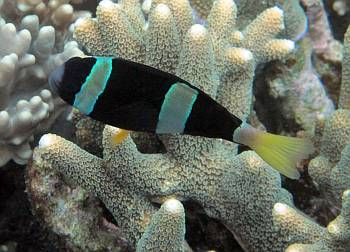 |
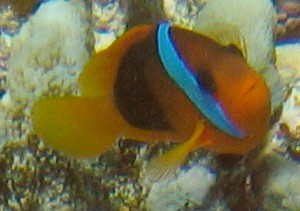 |
The adult Red And Black Anemonefish Amphiprion melanopus
(left) is found from Indonesia across the Pacific to French
Polynesia. Strangely, the adults in Tonga and Fiji vary from other
adults by having no black on the back. The young
(right) have 2 to 3 white (or pale blue/white) bars. They live with any of 3
different anemone species to 30' (10m) deep. (Adult: New Caledonia.
Juvenile: Tonga) |
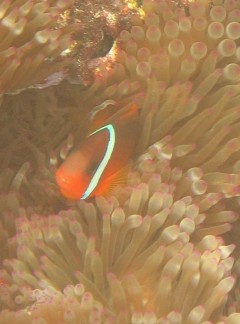 |
|
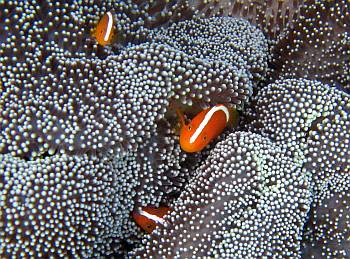 |
At left: A family of Orange Anemonefish Amphiprion sandaracinos (left) peer out from the
protective tentacles of a Merten's Anemone, the one anemone species that they prefer. The similar
looking Skunk Anemonefish Amphiprion akallopisos is found from East Africa to Bali,
Indonesia. Given that the fish at left were photographed in Eastern Indonesia we can be pretty sure they are
Orange Anemonefish, not the Skunk Anemonefish. (Triton Bay by Sue Hacking) At right, a
Spinecheek Anemonefish Premnas biaculeatus, guards her family in the protective arms of a
bulb-tentacle anemone. Females rule the family, and are always much larger than even the highest ranking
male who will be a brighter orange, rather than the dark color of the large female. When she dies, the
next male in line changes to a female, darkens and grows. The spine on the cheek is a quite visible on this
fish. They are found as deep as 59ft (18m). They are found Indonesia, Philippines and Papua New
Guinea, and south to the Great Barrier Reef. (Eastern Borneo. Photo by Sue Hacking)
|
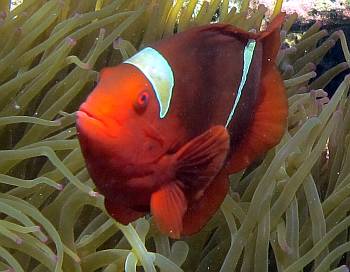 |
| The stunning Javanese Damsel juvenile Neoglyphidodon oxyodon eluded us for many years, until we
snorkeled near a natural fish nursery in Raja Ampat and saw literally dozens and dozens of these magnificent
juveniles. The adults have probably swum infront of us for years, but without getting any attention, as
they are pretty uniformly black, with maybe a very dark gray area above the pectoral fins. (Raja Ampat.
Photo by Sue Hacking) |
 |
|
 |
A very abundant fish on the reefs of Tonga was the unmistakable
Pacific Half-and-Half Chromis Chromis iomelas with its
black fore-body and white rear body. We saw them mostly on scuba dives
in more than 15 feet (5 meters) of water. They grow to just under 3
inches (about 8 cm) and were found either in large groups or solitary,
such as the one above that swims over a blooming leather coral. (Tonga) |
| The more subtly colored Staghorn Damsels Amblyglyphidodon
curacao live near Acropora coral on shallow reefs in the western
Pacific from Vanuatu, Fiji and Samoa north to Japan and south to the
Great Barrier Reef of Australia. They are abundant in Indonesia. They may be found as deep as 15 meters.
(Fiji) |
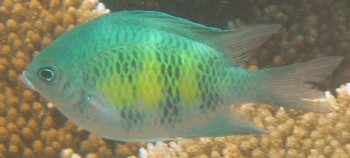 |

The lovely Blue Damsel Pomacentrus pavo is common on small coral heads in
French Polynesia. Their distinguishing mark, aside from the yellowish
tail, is a dark "ear" spot, just visible in this shot.
(Society Islands, Fr. Polynesia) |
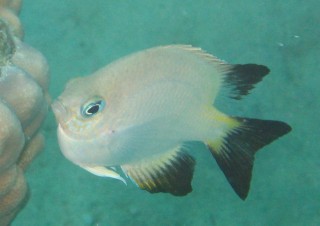
We saw this lovely little white and yellow, black-finned Damsel
on a dive in the Vava'u Group of Tonga in September. We have not
been able to identify it. Any help? (Tonga) |
| The Black Damsel Neoglyphidodon melas juvenile
is stark and colorful, belying its name. We have no good photo of
the adult, a fact which I shall blame on its featurelessness. To picture
it, envision a damsel-shaped black hole. Now compare that image with the
photo, and you will understand how the juvenile was once
considered to be a different species, until intermediates were found.
The Black Damsel is usually solitary and found on soft-coral reefs.
(Lizard Island, Australia) |
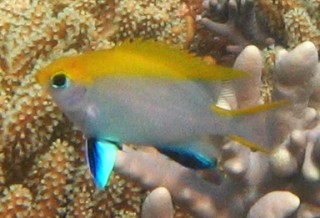 |
 |
The juvenile Three-spot Dascyllus Dascyllus trimaculatus (black and white,
left) are small damselfish that often hang out in anemones with Anemonefish
(orange face and white bar). As the former mature (right) they lose
their spots to become sort of drab gray/black fish about 5-6 inches
(15 cm) long. If they're not fully mature, they may still have a spot
or two, as in the picture on the right. The only distinguishing mark
is the pale rear dorsal fin. Strange how nature gives the striking patterns to juveniles and
leaves the adults alone. I would think a predator would find the
juveniles more easily than the adults! (Society Islands, Fr. Polynesia) |
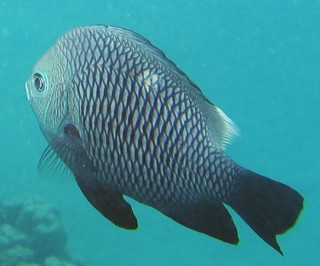 |
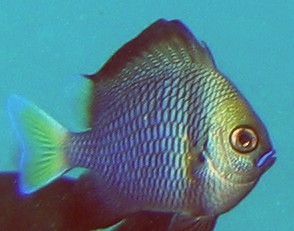
We think this is a Yellow-Tailed Dascyllus Dascyllus
flavicaudus, due to the yellow tail,
but the description in our guide talks of a medium brown to dark brown
body. (The blue-yellow sheen could just be the camera flash.) The dark
spot on the upper pectoral fin base is also characteristic. The
blue lip? Well, we don't know. (Society Islands) |
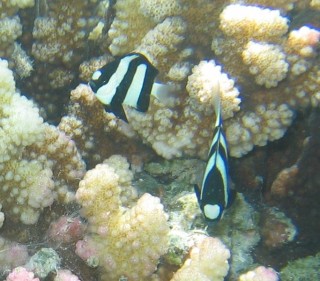
With the unlikely name of Humbug Dascyllus Dascyllus aruanus,
these bright splashes of black and white dart and swim around various coral heads
seeking shelter and eating algae and plankton. The white spot across the
eyes is characteristic, as is the black ventral fin. (Society Islands,
French Polynesia) |
| With its bright neon-blue stripe extending from snout to below the
rear dorsal fin, the 3-and-a-half-inch (8 cm) Surge Demoiselle
Chrysiptera brownriggii is hard to miss. It is found in surge channels and
outer reef flats to about 35 feet or 12 meters. (Fr. Polynesia) |
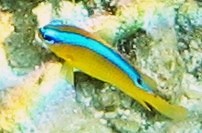 |
 |
The Yellowtail Demoiselle Neopomacentrus azysron
almost seems to be a different type of fish from the Surge Demoiselle
above, given its modest coloring. The black 'ear spot' above the
pectoral fin is characteristic. Yellowtail Demoiselles form schools to
12m. (Australia) |
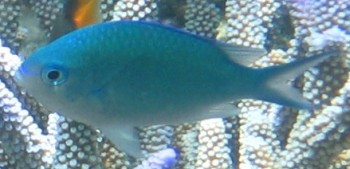 |
The tiny Blue-Green Chromis Chromis viridis (left and
right) grow to only 3 inches (7cm), but are bright against the
corals down to a depth of 65' (20 meters). They form large
schools around thick coral gardens. They can be anywhere from
blue to pale green, and have no distinctive markings except for a
faint line from the eye forward to the upper lip. This
characteristic is shared by the Black-Axil Chromis, which is
distinguished by a black spot at the base of the pectoral fin. Photo
right: Society Islands, French Polynesia. Photo left: Mamanucas, Fiji |
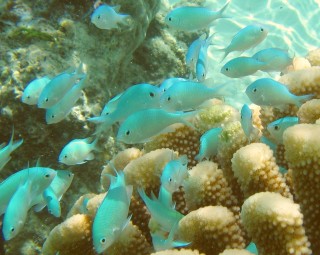 |
Up | Nudibranchs | Coral Reef | Venomous Animals | Angelfish | Butterflyfish | Damselfish | Puffers | Sharks & Rays | Snappers & Breams | Surgeon/Rabbit Fish | Triggerfish | Wrasse & Parrotfish | Other Reef Fish
Reef Animals | UW Photo How-to | Scuba Diving
Top Level:
Home |
Destinations |
Cruising Info |
Underwater |
Boat Guests |
Ocelot |
Sue |
Jon |
Amanda |
Chris |
Site Map |
Make a Comment
 |
Lifetime
Commodores
of the
Seven Seas
Cruising
Association |
 |
|
If our information is useful,
you can help by making a donation
|
Copyright © 2000‑2025 Contact:
Jon and Sue Hacking -- HackingFamily.com, svOcelot.com.
All rights reserved.
 Damselfish (family Pomacentridae) create bright ovals of energetic color on the
reefs. They are very common and so plentiful that the reef seems to be alive
with darting, turning, hiding, often curious small colorful ovals. There are
over 240 species of damselfish in the Indo-Pacific. They all have a continuous
dorsal fin and a forked or lunate tail. They are all egg layers. Either the male
or female makes a nest on the bottom where they engage in courtship displays of
rapid swimming and fin extension. They feed on algae or plankton. Included in
this family are damselfish, sergeants, chromis, Dascyllus, and demoiselles.
Photos copyrighted Hackingfamily.com, with credits to Christopher Hacking unless
otherwise noted.
Damselfish (family Pomacentridae) create bright ovals of energetic color on the
reefs. They are very common and so plentiful that the reef seems to be alive
with darting, turning, hiding, often curious small colorful ovals. There are
over 240 species of damselfish in the Indo-Pacific. They all have a continuous
dorsal fin and a forked or lunate tail. They are all egg layers. Either the male
or female makes a nest on the bottom where they engage in courtship displays of
rapid swimming and fin extension. They feed on algae or plankton. Included in
this family are damselfish, sergeants, chromis, Dascyllus, and demoiselles.
Photos copyrighted Hackingfamily.com, with credits to Christopher Hacking unless
otherwise noted.





















